7.6: Modeling with Trigonometric Equations
( \newcommand{\kernel}{\mathrm{null}\,}\)
Determining the Amplitude and Period of a Sinusoidal Function
Any motion that repeats itself in a fixed time period is considered periodic motion and can be modeled by a sinusoidal function. The amplitude of a sinusoidal function is the distance from the midline to the maximum value, or from the midline to the minimum value. The midline is the average value. Sinusoidal functions oscillate above and below the midline, are periodic, and repeat values in set cycles. Recall from Graphs of the Sine and Cosine Functions that the period of the sine function and the cosine function is 2π. In other words, for any value of x,
sin(x±2πk)=sinxandcos(x±2πk)=cosx
where k is an integer.
The general forms of a sinusoidal equation are given as
y=Asin(Bt−C)+D
or
y=Acos(Bt−C)+D
where amplitude=|A|,B is related to period such that the period=2πB,C is the phase shift such that CB denotes the horizontal shift, and D represents the vertical shift from the graph’s parent graph.
Note that the models are sometimes written as
y=asin(ωt±C)+D
or
y=acos(ωt±C)+D,
with a period that is given as 2πω.
The difference between the sine and the cosine graphs is that the sine graph begins with the average value of the function and the cosine graph begins with the maximum or minimum value of the function.
Show the transformation of the graph of y=sinx into the graph of y=2sin(4x−π2)+2.
Solution
Consider the series of graphs in Figure 7.6.1 and the way each change to the equation changes the image.
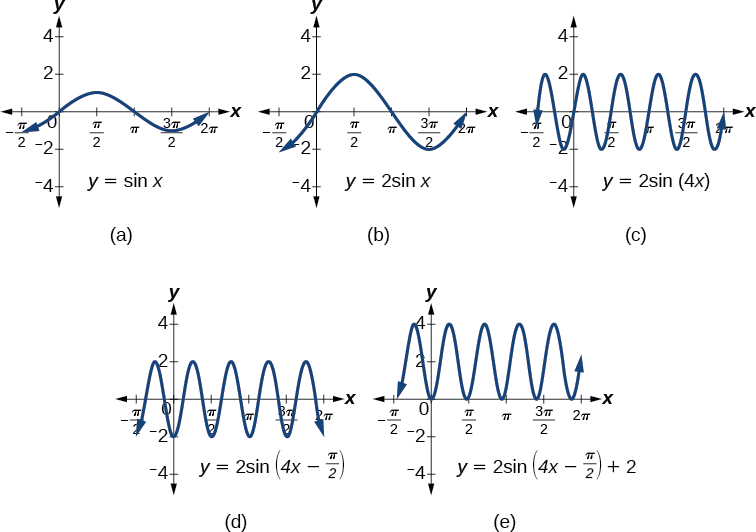
- The basic graph of y=sinx
- Changing the amplitude from 1 to 2 generates the graph of y=2sinx.
- The period of the sine function changes with the value of B, such that period=2πB. Here we have B=4, which translates to a period of π2. The graph completes one full cycle in π2 units.
- The graph displays a horizontal shift equal to CB, or π24=π8.
- Finally, the graph is shifted vertically by the value of D. In this case, the graph is shifted up by 2 units.
Modeling Periodic Behavior
We will now apply these ideas to problems involving periodic behavior.
The average monthly temperatures for a small town in Oregon are given in Table 7.6.1. Find a sinusoidal function of the form y=Asin(Bt−C)+D that fits the data (round to the nearest tenth) and sketch the graph.
| Month | Temperature,oF |
|---|---|
| January | 42.5 |
| February | 44.5 |
| March | 48.5 |
| April | 52.5 |
| May | 58 |
| June | 63 |
| July | 68.5 |
| August | 69 |
| September | 64.5 |
| October | 55.5 |
| November | 46.5 |
| December | 43.5 |
Solution
Recall that amplitude is found using the formula
A=largest value −smallest value2
Thus, the amplitude is
|A|=69−42.52=13.25
The data covers a period of 12 months, so 2πB=12 which gives B=2π12=π6.
The vertical shift is found using the following equation.
D=highest value+lowest value2
Thus, the vertical shift isD=69+42.52=55.8
So far, we have the equation y=13.3sin(π6x−C)+55.8.
To find the horizontal shift, we input the x and y values for the first month and solve for C.
42.5=13.3sin(π6(1)−C)+55.8−13.3=13.3sin(π6−C)−1=sin(π6−C)sinθ=−1→θ=−π2π6−C=−π2π6+π2=C=2π3
We have the equation y=13.3sin(π6x−2π3)+55.8. See the graph in Figure 7.6.9.
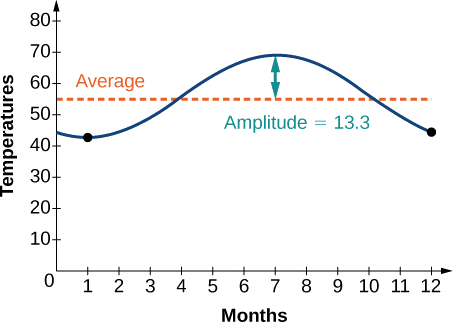
Modeling Harmonic Motion Functions
Harmonic motion is a form of periodic motion, but there are factors to consider that differentiate the two types. While general periodic motion applications cycle through their periods with no outside interference, harmonic motion requires a restoring force. Examples of harmonic motion include springs, gravitational force, and magnetic force.
Simple Harmonic Motion
A type of motion described as simple harmonic motion involves a restoring force but assumes that the motion will continue forever. Imagine a weighted object hanging on a spring, When that object is not disturbed, we say that the object is at rest, or in equilibrium. If the object is pulled down and then released, the force of the spring pulls the object back toward equilibrium and harmonic motion begins. The restoring force is directly proportional to the displacement of the object from its equilibrium point. When t=0,d=0.
We see that simple harmonic motion equations are given in terms of displacement:
d=acos(ωt)ord=asin(ωt)
where |a| is the amplitude, 2πω is the period, and ω2π is the frequency, or the number of cycles per unit of time.
For each the given functions:
- y=5sin(3t)
- y=6cos(πt)
- y=5cos(π2)t
address the following questions:
- Find the maximum displacement of an object.
- Find the period or the time required for one vibration.
- Find the frequency.
- Sketch the graph.
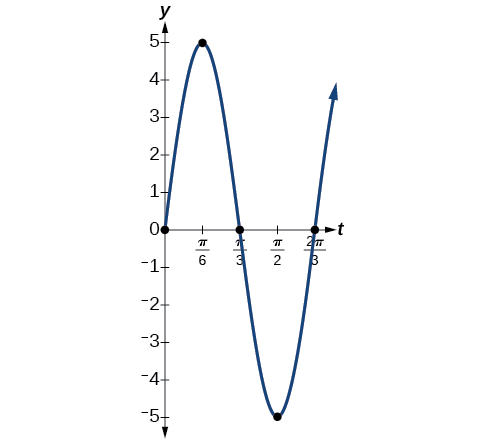
- Answer a
-
- The maximum displacement is equal to the amplitude,|a|, which is 5.
- The period is 2πω=2π3.
- The frequency is given as ω2π=32π.
- See Figure 7.6.13. The graph indicates the five key points.
- Answer b
-
- The maximum displacement is 6.
- The period is 2πω=2ππ=2.
- The frequency is ω2π=π2π=12.
- See Figure 7.6.14.
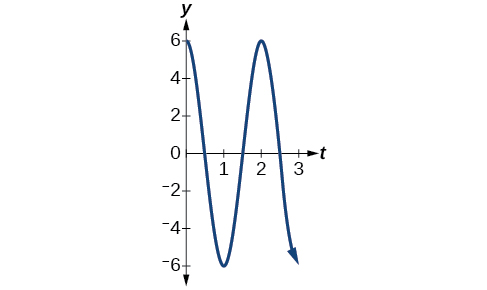
Figure 7.6.14 - Answer c
-
- The maximum displacement is 5.
- The period is 2πω=2ππ2=4.
- The frequency is 14.
- See Figure 7.6.15.
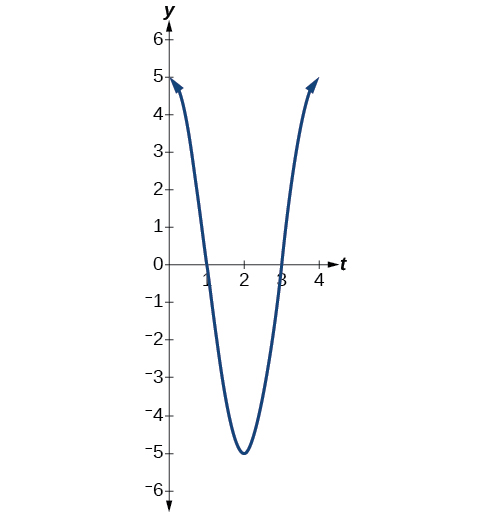
Figure 7.6.15
Damped Harmonic Motion
In reality, a pendulum does not swing back and forth forever, nor does an object on a spring bounce up and down forever. Eventually, the pendulum stops swinging and the object stops bouncing and both return to equilibrium. Periodic motion in which an energy-dissipating force, or damping factor, acts is known as damped harmonic motion. Friction is typically the damping factor.
In physics, various formulas are used to account for the damping factor on the moving object. Some of these are calculus-based formulas that involve derivatives. For our purposes, we will use formulas for basic damped harmonic motion models.
In damped harmonic motion, the displacement of an oscillating object from its rest position at time t is given as
f(t)=ae−ctsin(ωt) orf(t)=ae−ctcos(ωt)
where c is a damping factor, |a| is the initial displacement and 2πω is the period.
Model the equations that fit the two scenarios and use a graphing utility to graph the functions: Two mass-spring systems exhibit damped harmonic motion at a frequency of 0.5 cycles per second. Both have an initial displacement of 10 cm. The first has a damping factor of 0.5 and the second has a damping factor of 0.1.
Solution
At time t=0, the displacement is the maximum of 10 cm, which calls for the cosine function. The cosine function will apply to both models.
We are given the frequency f=ω2π of 0.5 cycles per second. Thus,
ω2π=0.5ω=(0.5)2π=π
The first spring system has a damping factor of c=0.5. Following the general model for damped harmonic motion, we have
f(t)=10e−0.5tcos(πt)
Figure 7.6.16 models the motion of the first spring system.
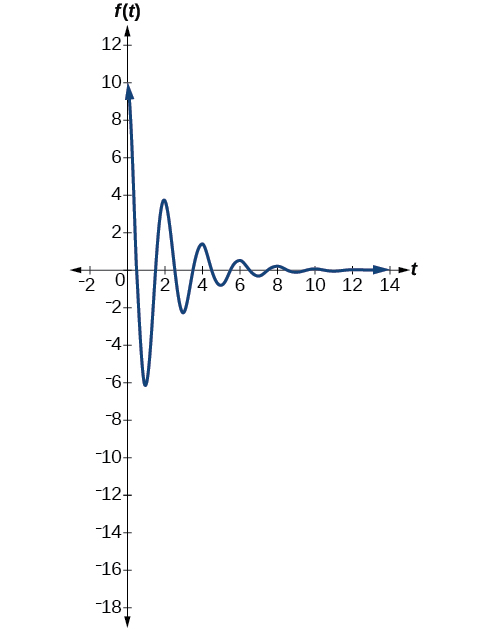
The second spring system has a damping factor of c=0.1 and can be modeled as
f(t)=10e−0.1tcos(πt)
Figure 7.6.17 models the motion of the second spring system.
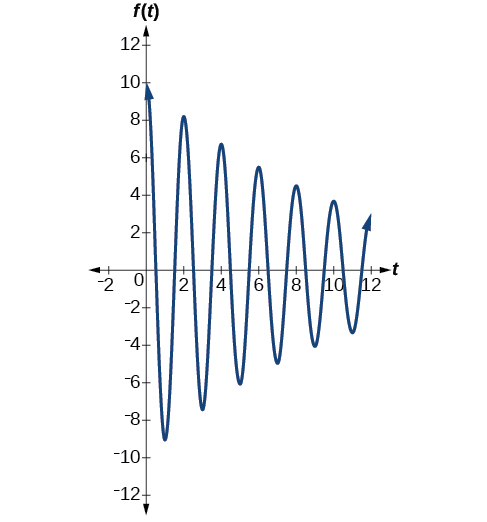
Analysis
Notice the differing effects of the damping constant. The local maximum and minimum values of the function with the damping factor c=0.5 decreases much more rapidly than that of the function with c=0.1.
Bounding Curves in Harmonic Motion
Harmonic motion graphs may be enclosed by bounding curves. When a function has a varying amplitude, such that the amplitude rises and falls multiple times within a period, we can determine the bounding curves from part of the function.
Graph the function f(x)=cos(2πx)cos(16πx).
Solution
The graph produced by this function will be shown in two parts. The first graph will be the exact function f(x) (see Figure 7.6.23;top;), and the second graph is the exact function f(x) plus a bounding function (see Figure 7.6.23;bottom). The graphs look quite different.

Figure 7.6.23
Analysis
The curves y=cos(2πx) and y=−cos(2πx) are bounding curves: they bound the function from above and below, tracing out the high and low points. The harmonic motion graph sits inside the bounding curves. This is an example of a function whose amplitude not only decreases with time, but actually increases and decreases multiple times within a period.


